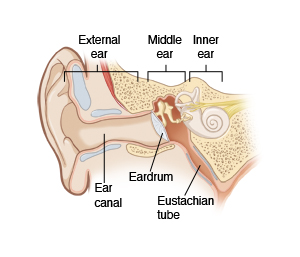The ear canal makes earwax from the canal’s lining. The ears make wax to lubricate and protect the ear canal. The ear canal is the tube that connects the middle ear to the outside of the ear. The wax protects the ear from bacteria, infection, and damage from water or trauma.
The wax that forms in the canal naturally moves toward the outside of the ear and falls out. In some cases, the ear may make too much wax. If the wax causes problems or keeps the health care provider from seeing into your ear, the extra wax may be removed.
Too much wax can affect your hearing. It can cause itching. In rare cases, it can be painful. Earwax should not be removed unless it is causing a problem. You should not stick objects such as cotton swabs into your ear to remove wax unless told to do so by your provider.
Health care providers can remove earwax safely. Often flushing the earwax out with water (irrigation) using a syringe will help. Sometimes devices or suction are used to remove the wax. It is important to stay still during the procedure to prevent damage to the ear canal. But removing earwax generally doesn’t hurt. You won't need anesthesia or pain medicine when the provider removes the earwax.
A number of conditions lead to earwax buildup. These include some skin problems, a narrow ear canal, or ears that make too much earwax. Using cotton swabs in the canal pushes earwax deeper into the ear and helps lead to the buildup of earwax.
Home care
-
The health care provider may advise mineral oil or over-the-counter (OTC) eardrops to use at home to soften the earwax. They may also advise a home irrigation or syringing kit. Use these products only if the provider advises them. Carefully follow the instructions given.
-
Don’t use mineral oil or OTC eardrops if you might have an ear infection or a burst (ruptured) eardrum. Tell your provider right away if you have diabetes or an immune disorder.
-
Don’t use cotton swabs in your ears. Cotton swabs may push wax deeper into the ear canal or damage the eardrum. Use cotton gauze or a wet washcloth to gently remove wax on the outside of the ear and around the opening to the ear canal.
-
Don't use any probing device or object such as cotton-tipped swabs or bobby pins to clean the inside of your ears.
-
Don’t use ear candles to clean your ears. Candling can be dangerous. It can burn the ear canal. It can also make the condition worse instead of better.
-
Don’t use cold water to rinse the ear. This will make you dizzy. If your provider tells you to rinse your ear, use only warm water or follow their instructions.
-
Check the ear for signs of infection or irritation (see below under When to get medical advice).
Steps for using eardrops
-
Wash your hands before and after using the eardrops.
-
Warm the medicine bottle by rubbing it between your hands for a few minutes.
-
Lie down on your side, with the affected ear up.
-
Place the advised number of drops in the ear. To help prevent medicine from leaking out, you may gently put a clean cotton ball into the ear opening.
Follow any other instructions from your provider.
Follow-up care
Follow up with your health care provider, or as advised.
When to get medical advice
Call your health care provider or seek medical care right away if you have:
-
Ear pain that gets worse.
-
Fever of 100.4°F (38°C) or higher, or as directed by your provider.
-
Wax buildup that gets worse.
-
Severe pain, dizziness, or nausea.
-
Bleeding from the ear.
-
Hearing problems.
-
Signs of irritation from the eardrops, such as burning, stinging, or swelling and soreness.
-
Foul-smelling fluid draining from the ear.
-
Signs of infection such as outer ear swelling, redness, or soreness.
-
Headache, neck pain, or stiff neck.


